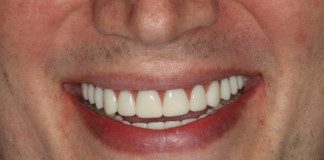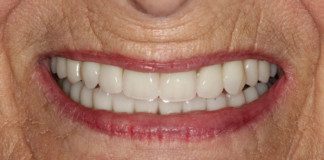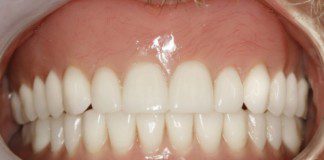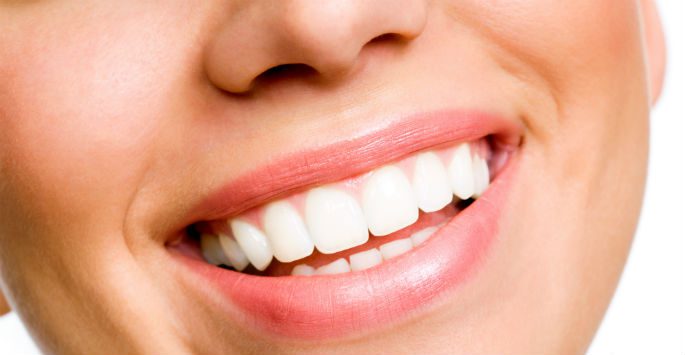 When all teeth need to be replaced, one of the options with the best return on investment is the Implant Overdenture.
When all teeth need to be replaced, one of the options with the best return on investment is the Implant Overdenture.
Denture wearers often worry about their teeth slipping, becoming loose, or falling out while performing normal activities like talking and eating. There are many denture adhesives and creams on the market today to help secure these dental prosthetics to your mouth, but many fall short in providing a confident grip that lasts throughout the day. Implant overdentures prevent the need for these products.
What are Implant Overdentures?
Implant Overdentures are dentures that are supported by dental implants, but are removed daily for cleaning and maintenance, offering a blend of convenience and improved dental health outcomes for people with missing teeth.
Implant Overdentures are often called “Snap-On Dentures” because the mechanisms used to connect the denture to the implants use various types of snap-on type assemblies. This Snap Assembly provides stability that regular dentures lack (prevents movement front to back and side to side) and retention (prevents the denture from moving away from the tissues).
Overdentures provide a middle ground between traditional dentures and full implant-supported, fixed (non-removable) dentures. They utilize implants to anchor the denture, yet allow for easy removal and cleaning. While they are more stable than traditional dentures, they may not offer the same level of comfort and permanence as full fixed implant dentures.
Because the Fixed Implant Dentures/ All-on-4 concept has become so popular, many patients are not offered this very good, less expensive option. Implant Overdentures are removable and larger than the Fixed Implant Bridges but the following benefits are worth considering:
- Lower cost (as much as half the cost)
- Much easier cleaning than the All-On-4. Because the prostheses can be removed, cleaning takes much less effort and time
- For patients with severe bone loss, implant overdentures can provide additional facial support. This is an advantage allowed by the denture extension under the lips to fill in the space where bone was lost
How Do Implant Overdentures Work?
This is a multi-step treatment process:
- Dental implants will be placed into the jaw and left to adhere to the jaw bone for about 2-3 months. This allows the bone to grow to the implant at a cellular level.
- A customized set of overdentures will be created for you to comfortably fit your mouth and replicate the correct shape size of a natural set of teeth. You can choose the shade, so if you want brighter, whiter teeth, you can have them!
- The overdentures will be attached to the implants for a secure, non-slip fit and worry-free teeth.
They have replaceable inserts inside the housing of the denture itself, which need to be replaced from time to time to keep things fitting snugly. These come in different strength/tightness levels, so we can find the fit that best suits your comfort level.
Types of Implant Overdentures
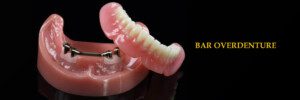
- Bar-Retained Overdentures
Bar-retained overdentures involve a metal bar that runs along the jawline, attached to two or more implants that are placed in the jawbone. The overdenture fits over the bar and is secured with clips or other types of attachments. This setup distributes the biting force more evenly across the jaw than traditional dentures, making it an excellent option for patients with significant bone loss who require the even distribution of forces to reduce the risk of implant failure. It’s also well-suited for those seeking a more stable and less intrusive option than conventional dentures, as it minimizes movement and provides a natural feeling of security and comfort.
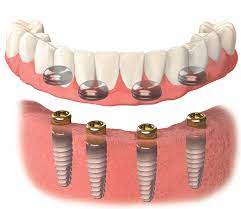
- Locator ® Attachment/Snap-On Overdentures
The LOCATOR® Implant Abutment System is arguably the World’s most popular implant attachment system. Specifically designed for full-arch or partial overdentures, the LOCATOR® Abutment system pivots and self-aligns to assure proper insertion, removal, and retention during function. During seating, the nylon male insert pivots inside the denture cap, centering the nylon male on the female abutment before engagement. This system offers standard and extended range retention inserts which are designed for maximum versatility, retention and angulation to suit each patient’s needs.
Suitability for Different Dental Conditions
The choice between bar-retained and ball-retained implant overdentures largely depends on the specific dental conditions and preferences of the patient. For individuals with extensive bone loss, bar-retained overdentures might be more suitable due to their ability to evenly distribute occlusal forces, thereby reducing stress on the individual implants. They are also preferable in cases where maximum stabilization is required, such as when the patient has a strong bite or prefers a firmer fit.
- Snap-on type overdentures, with their straightforward design and ease of use, are often favored by patients looking for a balance between functionality and convenience. They are ideal for those with adequate jawbone density who prefer a less complex system for daily removal and cleaning. Moreover, the snap-on mechanism can be more forgiving for patients with dexterity issues, making it easier to align and secure the denture.
Advantages
- Improved Stability and Comfort:One of the main advantages of implant overdentures is their stability compared to traditional dentures. Because they are anchored to implants in the jawbone, there is minimal risk of the overdentures slipping or moving, a common issue with conventional dentures. This stability significantly improves the wearer’s comfort and confidence while speaking, eating, and engaging in daily activities.
- Enhanced Oral Health:Implant overdentures contribute to better oral health. They help maintain jawbone integrity by stimulating bone growth, which prevents the bone loss often seen with traditional dentures. This not only preserves the facial structure but also benefits the health of adjacent teeth by providing them with a stable environment.
- Better Aesthetics and Functionality:Thanks to their secure fit, implant overdentures allow for a more natural look and feel. They are designed to mimic natural teeth closely, enhancing the wearer’s smile and overall facial aesthetics. Additionally, the improved functionality means individuals can enjoy a wider variety of foods, contributing to better nutrition and quality of life.
- Improved Chewing Ability:The stability provided by the implants supporting the overdenture provides better chewing than with conventional dentures, which slip and slide around in the mouth easily. It’s not AS GOOD as with implant bridges, but is significantly better than with removable dentures.
Disadvantages
- Higher Cost:The most significant drawback of implant overdentures compared to traditional dentures is their cost. The procedure involves surgical implantation, high-quality materials, and specialized dental expertise, all of which contribute to a higher price point than traditional dentures. This extra cost can make implant overdentures less accessible for some patients.
- Time-Consuming Process:The process of getting implant overdentures is lengthier than that for traditional dentures. It involves multiple stages, including surgery, healing time for osseointegration (the integration of the implant with the jawbone), and the fitting of the final overdenture once everything has fully healed and the implant have osseointegrated with the bone. This process can take several months, which might not be ideal for those seeking a quicker solution.
- Need for Sufficient Bone Density:Not everyone is a candidate for implant overdentures. A sufficient amount of healthy jawbone is required to anchor the implants securely. Patients with severe and significant bone loss, either from long-term denture wear or other factors, may need bone grafting before they can proceed with implant overdentures, adding to the cost and length of the treatment process.
- Less Stability and Comfort Than Fixed (Screwed-In Prostheses):Although overdentures are a significant improvement over traditional dentures, they are not quite as stable and comfortable as fixed teeth that are screwed onto the implants.
Alternatives
- Fixed implant bridgesare the “Cadillac” option, and is the option every dentist would want in their own mouth, if they ever faced total tooth loss. It is more technique sensitive and not all dentists are able to provide this treatment and not all patients are candidates. It involves anchoring artificial teeth to implants using minimal bone reduction methods and purposeful attention to preserving bone and gum tissues, for a very real, natural-looking result (even with lips retracted, when you can see everything). While fixed implant bridges are extremely stable and closely mimic natural teeth, they may not be an option for every patient because of financial reasons, sever lack of bone or because the dentist providing the services simply doesn’t have the experience or skillset.
- Traditional denturesare a common alternative to implant overdentures. They are non-invasive and less expensive upfront. However, they rest on the gums and are not anchored to the jawbone, which can lead to slippage and discomfort during eating or speaking. Over time, traditional dentures may require adjustments or replacements due to changes in the jawbone and gums.
- All-on-4 Dental Implant Dentures
The All-On-4 dental implant technique involves significant bone removal, and the placement of four dental implants in the jawbone, which then support a full arch of teeth. This protocol involves more bone removal than snap-on dentures or implant bridges to make room in the mouth for the prosthesis. It uses angled implants and angled abutments to support the prosthesis. While this option does offer a stable solution for tooth loss and is one option for those with significant bone loss who may not qualify for implant bridge procedures, we are not proponents of this rteatnebt protocol in our practice. While this has become a very popular treatment due to massive marketing efforts by practices who focus solely on “same day permanent teeth in a day”, we have found that in the long run, patients end up with major food entrapment issues, spaces between the gums and prostheses after prolonged healing, and difficulty cleaning them at home. For patients seeking this realm of treatment, we have better options in either fixed implant bridges or fixed implant dentures. (We have several informative videos on this subject explaining all the details and variables at
- Mini dental implantsare a less invasive alternative, often used to stabilize lower dentures. These implants are smaller in diameter, requiring less bone density for placement. Mini implants can be a cost-effective solution for patients seeking improved denture stability without the full scope of traditional implants. However, they may not offer the same level of support for heavier prosthetics like full overdentures.
Comparison
- When comparing these alternatives, it’s crucial to consider the patient’s specific needs, including oral health, bone density, lifestyle, and budget. Implant overdentures offer a balance of long-term functionality and aesthetics, making them an appealing choice for many who need full mouth tooth replacement but cannot afford fixed implant bridges or fixed dentures. The cost and surgical requirements may not suit everyone. Traditional dentures provide less invasive and more budget-friendly solutions, but may lack the long-term benefits of bone preservation and stability that implant bridges offer. With that said, they are still an excellent option for many patients for a variety of reasons listed above and many patients find them a good “middle of the road” option.
Am I a Good Candidate for Implant Overdentures?
The best way to find out if you are a candidate for this treatment is to schedule a consultation with Dr. McFadden. Using advanced imaging and diagnostics, we will thoroughly examine your individual condition and help you determine whether implant overdentures can provide optimal results for you. We will also discuss what you can expect throughout your treatment process, how to prepare, and any necessary aftercare information that may apply.
In general, anyone missing or soon to be missing their teeth are potential candidates for implant overdentures. Because we have implant sizes ranging from 1.5 mm to 6.0 mm in diameter and 6.5 mm to 17.0 mm in length, almost no one is disqualified for implant overdenture treatment.
What is the cost?
Initial Investment
The initial cost of implant overdentures is higher than that of traditional dentures. This is due to the surgical procedures required to insert the implants into the jawbone, the fabrication of custom overdentures, and the need for specialized dental expertise. On average, the price can range significantly based on geographical location, the experience of the dental practitioner, and the materials used. To find out what the cost would be for your individual situation, schedule a complimentary consultation with us. After a thorough examination, we will provide you with all the options available that suit your needs, accurate estimates of each and a review of the benefits, options and risks of each option.
Long-Term Savings
Despite the higher upfront cost than traditional dentures, implant overdentures can offer long-term savings. Traditional dentures often require adjustments, relining, and replacement over the years, which can add up in cost over time. In contrast, implant overdentures are more durable and stable, with the potential for fewer maintenance costs over time. Additionally, they help preserve the jawbone and maintain facial structure, potentially reducing the need for further dental procedures.
Insurance and Financing Options
Many dental insurance plans offer partial coverage for implant overdentures, recognizing them as a necessary treatment rather than a cosmetic one. However, coverage can vary widely, so it’s essential to review your insurance policy or discuss with your provider to understand what costs will be covered. For expenses not covered by insurance, our office will help you find financing plans or payment options to make the treatment more accessible. It’s also worth exploring health savings accounts (HSAs) or flexible spending accounts (FSAs), which can be used for such medical expenses.
Comparative Cost Analysis
When considering implant overdentures, conducting a comparative cost analysis with traditional dentures is beneficial. Factor in the expected lifespan of each option, the quality of life improvements, and potential savings from reduced dental complications and maintenance. Although the upfront cost of implant overdentures is higher than with traditional dentures, the long-term benefits and savings on future dental health expenses can make them a cost-effective solution for many people.
The cost varies greatly depending upon the region, the doctor’s training, implant type, number of implants and type of material used for the final restoration. Most common is the use of two or four implants for overdentures. If mini implants can be used the cost is much less (see section on Mini Implants). With regular implants you can expect an overall treatment cost range of $9,500 to 20,000.
Conclusion
Removable implant overdentures represent a paradigm shift in the approach to dental restorations, merging the stability and functionality afforded by dental implants with the flexibility and ease of maintenance associated with traditional dentures. As we have explored, the choice between bar-retained and snap-on systems, along with considerations for different dental conditions, underscores the importance of personalized dental care tailored to each patient’s unique needs. While the journey to selecting and adapting to implant overdentures involves navigating through considerations of cost, suitability, and the potential need for preparatory procedures like bone grafting, the long-term benefits—ranging from improved oral health to enhanced quality of life—make it a worthwhile investment for many.
Alternatives such as traditional dentures, fixed bridges, and fixed dentures offer viable options for diverse needs and circumstances, but the distinct advantages of implant overdentures in terms of stability, aesthetics, cost and functionality position them as a great choice for those seeking to restore their smiles. Ultimately, the decision to opt for implant overdentures, or any alternative, should be made in consultation with a Prosthodontist, taking into account the comprehensive analysis of costs, benefits, and individual patient goals to ensure the best possible outcome for dental health and patient satisfaction.
To learn more about Removable Implant Dentures/Overdentures and how we can help you please fill out the form below.

